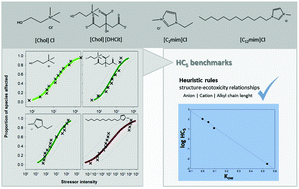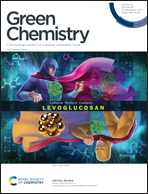Applicability of heuristic rules defining structure–ecotoxicity relationships of ionic liquids: an integrative assessment using species sensitivity distributions (SSD)†
Abstract
The toxicity of Ionic Liquids (ILs) to aquatic organisms has been a matter of substantial interest, involving the toxicity assessment for a small number of species, which is limitative given the variation in species sensitivity to different classes of ILs. Therefore, the main objective of this study was to validate, using an integrative approach (i.e., integrating the responses of several species), the heuristic rules that have been assumed for the ecotoxicity of ILs, namely the effects of the cation, elongation of the cation alkyl chain and anion moiety. For this purpose, four ILs were selected as models and their toxicity was determined for a wide variety of species, which allowed the development of species sensitivity distribution curves. The analysis of the distribution curves enables the determination of hazard concentrations affecting 5% of the represented communities (HC5) and also the establishment of structure–ecotoxicity relationships for ILs. The median effect concentration (EC50) values varied widely and the species most sensitive to each IL was variable. The integrative HC5 values varied by five orders of magnitude, between 3.020 × 10−3 mg L−1 representing the 1-dodecyl-3-metilimidazolium chloride, which raises concerns on the environmental hazardous potential of this IL, and 106.9 mg L−1 for cholinium chloride, which confirms its low environmental toxicity. The SSD approach showed cholinium chloride as the least toxic IL, followed by cholinium dihydrogenocitrate, 1-ethyl-3-methylimidazolium and 1-dodecyl-3-methylimidazolium chloride, as the most toxic. This illustrates the minor effect of the anion on toxicity for this set of ILs, whereas the cation and the cation alkyl chain length had pronounced effects, validating the heuristic rules defining structure–ecotoxicity relationships of ILs. A very strong linear correlation between hydrophobicity and HC5 was found (ρ = −0.9991). This approach allows a more efficient prediction of the potential environmental effects of ILs, thus preventing the need to comprehensively assess to the ecotoxicity of all ILs, which can be many within each family and each cation/anion possible combination. Ultimately, this will sustain the development of ILs posing less environmental hazards nonetheless retaining the desired performance.



 Please wait while we load your content...
Please wait while we load your content...